Here is the test of a template I will use to show the bears swimming. These bears, which are actually ephemeral embodiments of the river, will carry Eve for the first stage of her journey before they morph into wolves. I created this animation with clear black lines because I will be rotoscoping them later in photoshop for the desired look.
Monday, 26 April 2010
Wednesday, 21 April 2010
Mood board
Tuesday, 20 April 2010
Eve Design
Adobe Illustrator brushes
Below are some experiments with Adobe Illustrator brushes to help me to come to a decision as to the style I want for my animation. The plan is to animate clearly defined shapes as templates in Flash, such as the character design in my previous post, before exporting the stills to trace them in Illustrator.
The images below are traced from my storyboard for the National Gallery project. I have traced over most of the outlines in this case so the content of these still images are clear. Once it is animated, however, I think the movement will make the content of each frame more clear so that I can create fewer, subtler brushstrokes.
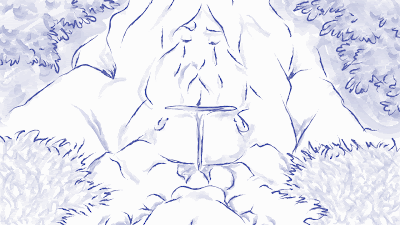
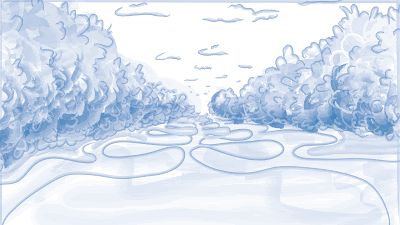
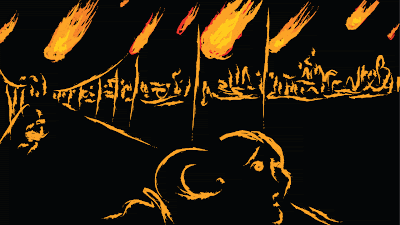
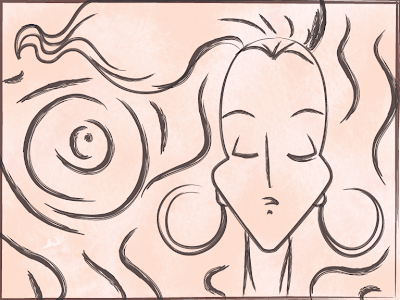
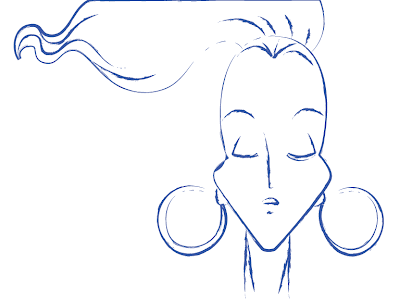
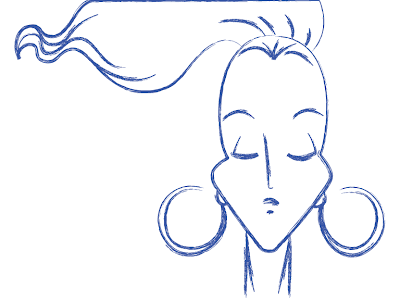
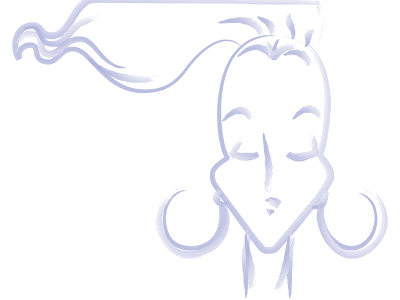
The images below are traced from my storyboard for the National Gallery project. I have traced over most of the outlines in this case so the content of these still images are clear. Once it is animated, however, I think the movement will make the content of each frame more clear so that I can create fewer, subtler brushstrokes.







Saturday, 17 April 2010
Eve

This is my first design for the protagonist of my animation. It is not the intended final visual style, but to be used as a motion template for tracing over at a later stage. I will animate this model in Flash and possibly trace where the highlights or shadows may be on the form in Illustrator or Photoshop.
I have called her Eve for now for the sake of convenience (so that I don't have to repeatedly write 'our protagonist' etc.) although I may change her name later depending on what I want her to represent, e.g. Lileth!! So far, she represents nobody in particular: any and every woman and man.
This is an unusual character design to me and required a careful balance between the principles and the aesthetics. I wanted a figure that conveyed a strong sense of ethnicity: her colouring is very washed out and her mouth, nose and hair are caucasian; her incredibly long arms and legs are like those of a male African athlete; her cheekbones and chin have tribal, mask-like qualities. If this is controversial, at least it will trigger some discourse!
I also wanted to convey strength without denying her femininity. For power, I gave her a strong neck, broad shoulders, long arms and large hands and feet. As these features are typically masculine, I balanced them out with broad hips, long legs, long hair and a tiny waist. Hopefully the unusual proportions won't make the animation look unconvincing.
Tuesday, 13 April 2010
As I was exploring, and, admittedly, getting lost in the National Gallery, I couldn't help being ensnared by 'The Thames below Westminster' (1871) by Claude Monet. It jumped out at me because although it's mystical and aesthetic, I could tell that Monet wasn't glamourising the scene and it is essentially a documentation of what the Thames was like at the moment Monet observed it and so it holds a similar fascination for me as century-old documentary photographs. It also shows London in a state of industrial development which has caused me to think about the evolution of the city of London and how it seems to epitomise contemporary global society.

I foolishly chose to disregard it at the time as I didn't see any narrative potential. However, it stuck in my mind and as I began my research for thematic inspiration by reading 'Landscape and Memory' by Simon Schama, this painting seemed to embody many of the ideas about cultural history that were of interest to me. It will also make this project a kind of site-specific artwork as it will give me the opportunity to reflect upon my acquaintance with the city of London this year. I moved to London for the first time in October and it is a truly fascinating place - I would love for it to feature literally in my final project. Hollywood treats LA, and otherwise New York, as the centre of the universe; London is often spoken of in a similar manner by Londoners and in the media.
I have also been reading 'The Ultimate Encyclopedia of Mythology' by Arthur Cotterell and Rachel Storm and am attempting to plough through it cover to cover. It is concise and a good starting point, although it disregards any kind of mythology outside of Europe and Asia! In my research, I have been keeping an eye out more for mythological figures that represent a particular kind of relationship towards the environment and figures of life, death and renewal, breezing over the love affairs and warriors.
My current idea is to animate a journey upstream from London to the source of the Thames in a similar attitude to Marlow's journey to the Heart of Darkness. My tale will move in the opposite direction to Conrad's, geographically, temporally, spiritually and conclusively!
The character is thrown into the river from the middle of Millenium Bridge during an apocalyptic nuclear war in London, whereupon time is frozen. As the character travels upstream, they travel backwards through the millenia to the source of civilisation in Britain, where they become assimilated into the landscape. Along my character's journey upstream, I wish to incorporate various mythological motifs. There is a risk of the film becoming too cluttered so I may have to limit myself to Celtic mythology.
My character will drift, unconscious, on her back, serenely flowing through the water. She awakes to find herself transported upstream by a current that takes the form of various extinct species from England throughout the ages. The camera spans over the landscape with great exertion of speed at times, always following the river. Our character catches up to indicate the great distance she covers and the inconsistency of time. As the river narrows, she is passed from the backs of fish to animated water droplets that carry her beyond the source of the river. She is then passed to the blades of grass and carried to the peak of a mountain. When the grass is gone, she is tossed up by the wind in somersaults. Sitting at the top of the mountain, she somehow becomes assimilated into the landscape, e.g. she transforms into a seed, flower or acorn, is blasted upwards and then into a forest.
I am trying to achieve a tricky balance between:
1) creating a conventionally structured and easily grasped narrative that will appeal to every audience.
2) challenging the assumption that all animation must be commercially accessible, experimenting with unconventional narratives/ non-narrative forms, e.g. depicting an experience rather than an event.
Of course, it would be a mistake to venture too far in the latter direction, as this is a character animation course, after all and by definition needs to focus on the animation of a character! It could also be professionally irresponsible of me to scare away commercial studios by rebelling in this way, but it's a risk I'm willing to take.
Epic, I know, but it doesn't have to be longer than a minute. When people speak of their life flashing before their eyes, it takes but a fleeting moment. Likewise, I want to attempt to contain the impression of tens of thousands of years. Hey, it wouldn't be exciting if it weren't a challenge!

I foolishly chose to disregard it at the time as I didn't see any narrative potential. However, it stuck in my mind and as I began my research for thematic inspiration by reading 'Landscape and Memory' by Simon Schama, this painting seemed to embody many of the ideas about cultural history that were of interest to me. It will also make this project a kind of site-specific artwork as it will give me the opportunity to reflect upon my acquaintance with the city of London this year. I moved to London for the first time in October and it is a truly fascinating place - I would love for it to feature literally in my final project. Hollywood treats LA, and otherwise New York, as the centre of the universe; London is often spoken of in a similar manner by Londoners and in the media.
I have also been reading 'The Ultimate Encyclopedia of Mythology' by Arthur Cotterell and Rachel Storm and am attempting to plough through it cover to cover. It is concise and a good starting point, although it disregards any kind of mythology outside of Europe and Asia! In my research, I have been keeping an eye out more for mythological figures that represent a particular kind of relationship towards the environment and figures of life, death and renewal, breezing over the love affairs and warriors.
My current idea is to animate a journey upstream from London to the source of the Thames in a similar attitude to Marlow's journey to the Heart of Darkness. My tale will move in the opposite direction to Conrad's, geographically, temporally, spiritually and conclusively!
The character is thrown into the river from the middle of Millenium Bridge during an apocalyptic nuclear war in London, whereupon time is frozen. As the character travels upstream, they travel backwards through the millenia to the source of civilisation in Britain, where they become assimilated into the landscape. Along my character's journey upstream, I wish to incorporate various mythological motifs. There is a risk of the film becoming too cluttered so I may have to limit myself to Celtic mythology.
My character will drift, unconscious, on her back, serenely flowing through the water. She awakes to find herself transported upstream by a current that takes the form of various extinct species from England throughout the ages. The camera spans over the landscape with great exertion of speed at times, always following the river. Our character catches up to indicate the great distance she covers and the inconsistency of time. As the river narrows, she is passed from the backs of fish to animated water droplets that carry her beyond the source of the river. She is then passed to the blades of grass and carried to the peak of a mountain. When the grass is gone, she is tossed up by the wind in somersaults. Sitting at the top of the mountain, she somehow becomes assimilated into the landscape, e.g. she transforms into a seed, flower or acorn, is blasted upwards and then into a forest.
I am trying to achieve a tricky balance between:
1) creating a conventionally structured and easily grasped narrative that will appeal to every audience.
2) challenging the assumption that all animation must be commercially accessible, experimenting with unconventional narratives/ non-narrative forms, e.g. depicting an experience rather than an event.
Of course, it would be a mistake to venture too far in the latter direction, as this is a character animation course, after all and by definition needs to focus on the animation of a character! It could also be professionally irresponsible of me to scare away commercial studios by rebelling in this way, but it's a risk I'm willing to take.
Epic, I know, but it doesn't have to be longer than a minute. When people speak of their life flashing before their eyes, it takes but a fleeting moment. Likewise, I want to attempt to contain the impression of tens of thousands of years. Hey, it wouldn't be exciting if it weren't a challenge!
Planning for the National Gallery Project
Our greatest and last assignment for this year is to create an animation inspired by one of the paintings from the permanent collection at the National Gallery. You can browse their collection at this address: http://nationalgallery.org.uk/paintings/
It might appear that their are too many options, but knowing already that I would not choose an aristocrat's portrait, a medieval Madonna and Child, or the classical depiction of Greco-Roman myth narrowed down the choices considerably!
Although I tried to enter the gallery with an open mind, I was interested at the time in different ways of visualising landscape, so my inspiration radar was biased. The first painting that appeared full of possibilities for me was 'Lake Keitele' (1905) by Akseli Gallen-Kallela. This is a very sensual painting, where you can feel the cool, smooth fluidity of the lake simply by looking, i.e. haptic visuality. The tranquility represents the purity of the unspoilt Finnish landscape to me and reflects the whispered mystery of its cultural history.
The choice of framing and composition is unconventional; it would be interesting to know if this is because Gallen-Kallela is making a deliberate statement about the conventions of landscape painting or because the artist comes from a tradition of landscape visualisation where this kind of imagery is not altogether unusual.
The ripples in the foreground were supposedly formed by the passing of a Norse god on his boat; this opens up a great deal of thematic and narrative potential for an animation. It certainly highlights the specificity of a particular moment in time and therefore the transience of reality in visualising landscape, akin to Turner's experiments with painting the same subject at different times of day.
The choice to represent an epic tale with such a gentle stroke makes classical paintings of mythology appear crude in comparison and overly illustrative. I know very little of Finnish culture, but this subtlety seems to exemplify this country's general personality in the global community today. Perhaps it is a statement about how these ancient cultural traditions are slipping into the past, as they are only a whisper next to the blaring rabble of globalised media entertainment.

I have been interested in exploring Norse culture for while and this painting would offer the perfect opportunity. However, as this may be the only personal animation of any substantial length I will have the opportunity to create for a while, it is important that it bears some meaning to me on another level. As I have no personal connection to Finland and could only hope to gain a superficial understanding of the significance of Lake Keitele to the artist, I would neither be able to do the painting justice, nor to tap into any deeper understanding of life.
It might appear that their are too many options, but knowing already that I would not choose an aristocrat's portrait, a medieval Madonna and Child, or the classical depiction of Greco-Roman myth narrowed down the choices considerably!
Although I tried to enter the gallery with an open mind, I was interested at the time in different ways of visualising landscape, so my inspiration radar was biased. The first painting that appeared full of possibilities for me was 'Lake Keitele' (1905) by Akseli Gallen-Kallela. This is a very sensual painting, where you can feel the cool, smooth fluidity of the lake simply by looking, i.e. haptic visuality. The tranquility represents the purity of the unspoilt Finnish landscape to me and reflects the whispered mystery of its cultural history.
The choice of framing and composition is unconventional; it would be interesting to know if this is because Gallen-Kallela is making a deliberate statement about the conventions of landscape painting or because the artist comes from a tradition of landscape visualisation where this kind of imagery is not altogether unusual.
The ripples in the foreground were supposedly formed by the passing of a Norse god on his boat; this opens up a great deal of thematic and narrative potential for an animation. It certainly highlights the specificity of a particular moment in time and therefore the transience of reality in visualising landscape, akin to Turner's experiments with painting the same subject at different times of day.
The choice to represent an epic tale with such a gentle stroke makes classical paintings of mythology appear crude in comparison and overly illustrative. I know very little of Finnish culture, but this subtlety seems to exemplify this country's general personality in the global community today. Perhaps it is a statement about how these ancient cultural traditions are slipping into the past, as they are only a whisper next to the blaring rabble of globalised media entertainment.

I have been interested in exploring Norse culture for while and this painting would offer the perfect opportunity. However, as this may be the only personal animation of any substantial length I will have the opportunity to create for a while, it is important that it bears some meaning to me on another level. As I have no personal connection to Finland and could only hope to gain a superficial understanding of the significance of Lake Keitele to the artist, I would neither be able to do the painting justice, nor to tap into any deeper understanding of life.
Subscribe to:
Posts (Atom)


